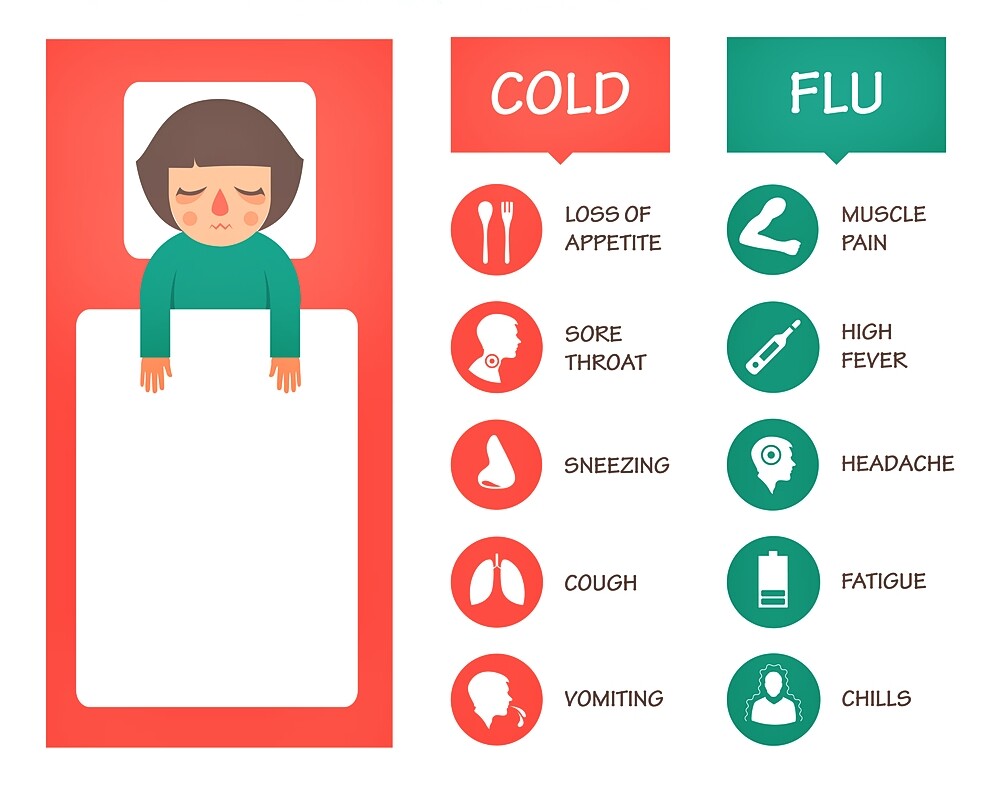The throat scratches, the nose runs, the temperature rises. Flu or cold? Here you will find the typical characteristics to distinguish.
Influenza, flu or cold? The symptoms are similar, but on closer examination the different diseases can be distinguished from each other. We explain the differences and clarify when the medicine chest à la chicken soup and acetylsalicylic acid is no longer sufficient to alleviate the symptoms and in which cases flu vaccination is advisable.
Flu or cold?
The terms flu and cold are often, but incorrectly, used synonymously, as both diseases manifest themselves in quite similar symptoms. Then there is the flu-like infection – another name for cold – which causes even more confusion. However, there are some distinguishing features that can help with the question “flu or cold?
Common cold
- Trigger: A cold can be triggered by up to 200 different viruses, for example rhinoviruses.
- Beginning of the disease: A flu-like infection tends to announce itself gradually, possibly over several days.
- Body temperature/ fever: The body temperature rises to a maximum of 38 degrees Celsius when a cold occurs.
- Cold: The nose runs or is blocked, it is red and swollen. The mucous membranes are strained by frequent sneezing. In some cases the cold symptoms of a flu-like infection are also accompanied by inflammation of the sinuses.
- Coughing: At the beginning and end of a cold, coughing usually occurs as a dry irritable cough. In the meantime, mucusy coughing is possible. You can find out what helps here: Severe cough.
- Sore throat: Scratching pain in the throat is often the first sign of a cold. You can find out what helps here: Home remedy for sore throat.
- Headaches and aching limbs: Mild headaches and aching limbs occur in the vast majority of people affected by a cold.
- General condition: People with a cold are limp, weak and feel exhausted.
- Course of the disease: You will normally get over a common cold after seven days, but after nine days at the latest.
Flu
- Trigger: An influenza is triggered by the influenza viruses.
- Beginning of the disease: The symptoms of influenza appear quite suddenly. While you were still feeling well at one moment, a few hours later you are already feverish.
- Body temperature/ fever: The fever during influenza should not be underestimated. It comes suddenly and often reaches body temperatures above 39 degrees Celsius, accompanied by chills and sweating.
- Cold: Typical cold as we know it from a cold, occurs during a flu rather rarely or less pronounced.
- Cough: A flu is accompanied by a dry and painful cough. Mucous membranes and sinuses are irritated.
- Sore throat: The average flu patient is also not spared from sore throat and severe difficulty swallowing.
- Headaches and aching limbs: Almost all people who suffer from flu suffer from severe headaches that resemble migraines as well as muscle and limb pain.
- General condition: People suffering from flu only want to go to bed. Paralyzing tiredness, severe exhaustion and an agonizing feeling of illness are classic symptoms.
- Course of disease: Whoever has the flu needs patience. You should be back on your feet after about seven to 14 days, but it can take several weeks before you recover completely.
Flu or cold: When is a visit to the doctor advisable?
Cold patients usually survive their colds well alone with a lot of chicken soup, nasal spray and a good supply of tissues. But that does not mean that you should take your cold lightly. The immune system is weakened and is susceptible to further infections if you are not careful enough. Doctors speak of a so-called superinfection.
If you have a real flu, a visit to the doctor is highly recommended. The specialist can help with the nagging symptoms such as high fever and severe headaches and aching limbs by prescribing pain-relieving and antipyretic medication, for example preparations containing acetylsalicylic acid (ASA) or the active ingredients ibuprofen and paracetamol. The best tips can be found here: Reduce fever.
Caution is especially important for older and chronically ill flu patients. Influenza can cause serious secondary diseases such as pneumonia or inflammation of the heart muscle. For these high-risk people, annual flu vaccination is recommended in good time before the flu epidemic.
Preventing flu and colds
So that you don’t catch it in the first place, here are a few useful tips on how you can prevent a flu or cold:
- Regular hand washing
- Avoid shaking hands during the flu epidemic
- Cough and sneeze always in the elbows
- Keep mucous membranes moist
- Strengthening of the immune system through lots of exercise in the fresh air, alternating showers and regular sauna sessions
By the way, here you can learn all about a cold nose.

